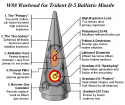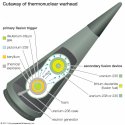View attachment 62527
China warhead design..
Should be comparable to US W88 yield I assume?
View attachment 62527
China warhead design..
Should be comparable to US W88 yield I assume?
The DF-41 carries 10 MIRVs I thought ... I would be surprised if China was not close to the US in warhead miniaturization because even in 1996, the US Congress was panicking about how China had acquired a W76/W88 class warhead through what they thought was espionage. Its been a quarter century since then and given Chinese advances in technology especially in super computing, they should have a very miniaturized warhead by now.W88 is compact for MIRV. As far as we've known Chinese MIRV capable ICBMs and SLBMs don't carry anywhere near as many warheads as the latest American ones due to warhead miniaturisation. The Chinese compact MIRV warhead yields are a mystery.
The DF-41 carries 10 MIRVs I thought
I couldn't read Chinese, so I could only guess the design based on picture and hints of the isotope no. in the labels. It seems like the Chinese warhead design is quite different from the W88 design. For comparison, see the Wikipedia image for the W88 design below:View attachment 62527
China warhead design..

NK is a independent sovereign state, not a puppet of China.China nuclear weapon design is actually very heavy and hard to carry by slbm.. that's why they use north korea as test site...So no global backlash.. 2017 nuclear test which is estimate to be 150kt is probably collaboration between chinese and north korean...there's no way north korean want to test nuke without consent from chinese government
China nuclear weapon design is actually very heavy and hard to carry by slbm.. that's why they use north korea as test site...So no global backlash.. 2017 nuclear test which is estimate to be 150kt is probably collaboration between chinese and north korean...there's no way north korean want to test nuke without consent from chinese government
This forum's perennial question.And your source is?
I couldn't read Chinese, so I could only guess the design based on picture and hints of the isotope no. in the labels. It seems like the Chinese warhead design is quite different from the W88 design. For comparison, see the Wikipedia image for the W88 design below:
View attachment 62531
In the Chinese warhead design, the primary stage is below, and the secondary is on top. While its exactly opposite for the W88 with the primary on top and the secondary below. Notice that in the Chinese warhead, the primary is actually bigger than the secondary stage. The primary is also not 'egg-shaped' like in the W88, that is why it is relatively 'fat' and needs to be placed in the wider end of the MIRV warhead.
This raises some interesting questions:
1) Why is the Chinese primary not 'egg shaped' like the W88? The 'egg shape' is useful for squeezing the primary into the narrow end of the MIRV.
2) But does the egg-shape necessitates the use of booster Tritium gas to give a sufficient yield?
2) So if the Chinese warhead sticks to the traditional spherical primary. Does the Chinese warhead not use booster Tritium gas for the primary?
Tritium has a relatively short half-life of 12.5 years, which makes warheads using Tritium booster gas quite maintenance extensive. So if the Chinese design does not use it, it could be cheaper to maintain, but it could cost the weapon quite a good bit of yield.
Maybe the answers are already written in Chinese in your shared image. It would be great if anyone can help to translate them.
Just another comment on the Chinese warhead yield figures. I haven't found hard official Chinese govt figures on their MIRV yields, but unofficially I have seen the yield figures maxed out on 150kT. This is nowhere near the 475kT yield of the W88. A Trident II can carry up to 8 x W88, and that packs more than double the punch compared to 10 x 150kT MIRV on a DF-41.
Nevertheless, I think this max 150kT yield is a deliberate design though. It still compares favorably to some contemporary NATO designs. The French M51 SLBM carries up to 10 x 100kT MIRVs. And the Trident II SLBM can carry up to 14 x 100kT W76 (US), or 14 x 100kT Hollbrook (UK).


